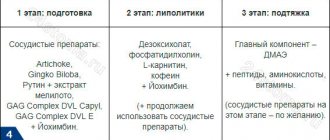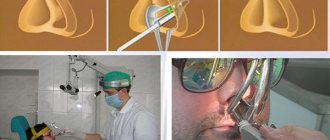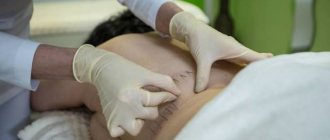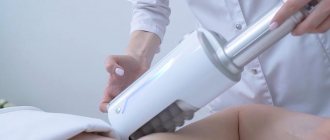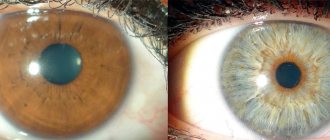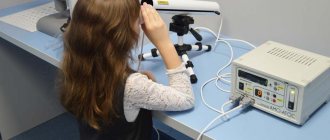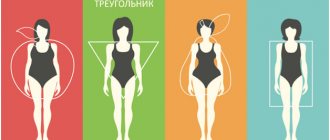The process of synthesis (accumulation) of fats is called lipogenesis , and breakdown is called lipolysis .
Fat synthesis is regulated by the reactions of carbohydrate metabolism and, very importantly, the number of stored fat cells is determined by the amount of carbohydrates contained in the diet, not fats. Simply put, if you eat a lot of carbohydrates - confectionery, sweets, pasta, sausages - there is a high probability of depositing new fat reserves.
What is the lipolysis procedure and what is its essence?
Lipolysis is a natural process that constantly occurs in the body, breaking down fat reserves into fatty acids and glycerol under the action of certain enzymes, in particular lipase. This principle underlies the salon procedure of the same name.
During lipolysis, one fat molecule is divided into three separate fatty acid molecules and one glycerol molecule.
Many people do not see the difference between lipolysis and liposuction. These are two completely different methods. Liposuction involves non-surgical intervention, and lipolysis is a non-surgical method of getting rid of fat reserves.
The essence of the procedure is the breakdown of fats. Unlike liposuction, they are not removed from the body. The lipolysis procedure simply “spurs up” the process of biochemical breakdown of fat. It can be performed on different parts of the body. Lipolysis is often practiced as the only way to remove a double chin.
Most often, lipolysis is performed on problem areas such as the abdomen, inner thighs, shoulders, and back. As a result of the procedure, fat cells are not removed or damaged, they are simply “deflated” – reduced in volume.
What about hardware techniques?
Let's look at their features:
- Ultrasonic lipolysis (US) is a non-invasive method based on the ability of focused ultrasound radiation to destroy the fat cell membrane. Once it is destroyed, the fat is released and excreted by the liver. This method is effective in removing small fat deposits. The most effective devices are Hifu, Altera, Exelis, Ultraformer 3;
- Radio wave lipolysis (RF) is the effect of short radiofrequency pulses, during which the fatty acids are heated, which stimulates lipolysis (one of the most popular is Scarlett). RF, like ultrasound, stimulates collagenosis, which leads to improved skin quality;
- Laser lipolysis is the most effective, but also the most dangerous of the above methods for losing weight, since there is a risk of necrosis, because essentially this method of lipolysis is based on strong heating of adipose tissue. This triggers the natural but enhanced process of breaking down fats into glycerol and fatty acids. Rehabilitation is short, but may be a little longer than after previous methods. There are such types of laser lipolysis: diode laser lipolysis, cold laser lipolysis, diode lipolysis, cold diode lipolysis.
Types of lipolysis
There are several types of lipolysis:
- laser;
- ultrasonic;
- needle;
- injection;
- electrode;
- radio wave.
The most effective method in a particular case is selected by a specialist, taking into account the degree of neglect of problem areas and the characteristics of the patient’s body. Each of them has advantages and disadvantages.
Laser lipolysis
The procedure is also called cold or diode lipolysis. It is based on the action of low-intensity laser radiation, which the device delivers in doses under the skin through a special probe, effectively breaking down fat cells. The products formed after breakdown are subsequently eliminated from the body. Cosmetic clinics position this type of lipolysis as an alternative to laser liposuction. The method is completely painless.
Ultrasonic lipolysis
The procedure is based on ultrasonic waves, which have proven effective in many areas of cosmetology. During the session, the specialist attaches pads to problem areas. With their help, an ultrasonic wave of different frequencies is supplied, which helps influence the speed of movement of fat molecules. Thanks to the variable frequency, there is a painless effect on the deep subcutaneous fat layers and activation of enzymes. The procedure involves the use of low frequency ultrasound: up to 24,000 Hz.
This non-invasive method is practiced in a course for a month, 2-3 times a week. After its completion, the skin in problem areas becomes smooth, and the volume decreases well due to the reduction of adipose tissue.
Needle lipolysis
The method involves influencing fat reserves through special needles. An electrical impulse of variable frequency is transmitted through them, which will enhance the effect of lipolysis.
There may be some discomfort at the site of exposure to needles. At the client's request, the specialist can use anesthetic cream or lidocaine.
Injection lipolysis
The technique is often called “weight loss injections.” The mechanism of the procedure is simple and resembles mesotherapy - fat deposits are affected by injections, which include lipolytics. These are special preparations based on phosphatidylcholine, a natural enzyme (lecithin) found in soybeans, eggs, and sunflower seeds. A similar substance is produced by the body itself to support various vital processes, including fat metabolism. In combination with other ingredients, lipolytics allow you to accelerate the breakdown of fat cells and naturally remove them from the body. The procedure brings slight discomfort at the injection sites.
Lipolitics are injected locally into the problem area with a very thin disposable needle to a depth of about 12 mm - into the subcutaneous fat. The duration of the session is 15-20 minutes. To speed up the results and increase the effectiveness of lipolytics, the procedure should be combined with LPG massage, thermolifting, pressotherapy, and pneumomassage.
Electrode lipolysis
The procedure is carried out using electrodes that transmit electrical impulses. They are placed on problem areas of the body. Electrode lipolysis is capable of changing the polarity of cell membranes in tissues and launching an active process of breakdown of subcutaneous fats.
Radio wave lipolysis
The procedure is also called RF lipolysis. It is based on the effect of electric current on human tissue. When the temperature rises by just 10°C when exposed to current, intracellular fat is broken down twice as fast. This explains the principle of operation of radiofrequency lipolysis.
On average, a course of radio wave lipolysis consists of 3-4 procedures with an interval of 10 days. In some cases, the effect is noticeable after the first procedure.
How to perform lipolysis correctly?
Lipolysis is necessary in the treatment of cellulite and local obesity. But before you try to use various methods to shake up this “cellulite” fat, you need to think about how to dispose of lipolysis products. If this is not taken care of in advance, the resulting triglycerides will simply migrate to another place. It’s good if this place is adipose tissue. It is also possible that lipolysis products may be deposited in the form of atherosclerotic plaques on the walls of blood vessels.
How is fat utilized? Through movement! It is in the “furnace” of the working muscle that free triglycerides are burned. When performing lipolysis, we necessarily include myostimulation and/or physical exercises in the complex of procedures.
Efficiency of lipolysis
The final result from a lipolysis course depends on the person’s age, initial weight and skin type. Numerous reviews confirm that the procedure is effective only in an integrated approach, which includes a proper diet and regular exercise. The method does not replace fitness and diet. Lipolysis is one of the ways to get rid of unnecessary fat deposits, but not a panacea in the fight against hated kilograms. If you eat improperly, the effect of the procedure will quickly fade away, and active lipogenesis will begin in the body - the reverse process of lipolysis.
Introduction
Metabolic and degenerative disorders associated with nutritional imbalances (cardiovascular pathology, diabetes, obesity, depression, etc.) are the most common diseases in the world [1]. Such diseases are comprehensively studied by researchers: food, environmental conditions, genetics, phenotype (epigenetics). Despite ongoing research in this area, the incidence of obesity and metabolic disorders is increasing sharply following changes in lifestyle and nutrition, especially with diets high in fructose and fat [2]. This epidemic is accompanied by cognitive and affective disorders, oxidative stress and damage to key enzymes in physiological homeostasis.
What risks are possible with lipolysis?
In fact, the liposis procedure is in many ways similar to the natural process of fat burning in the body, so the risks are minimal, but they still exist. Since destroyed cells are excreted through the liver, the load on it increases significantly. Before prescribing lipolysis, a good specialist will make sure that the patient’s liver is in order and its reaction to the frantic regime will be adequate. With caution and only after consultation with a doctor, laser lipolysis can be performed for people with poor blood clotting.
Features of the process of burning fat (lipolysis) in the body
To understand how the body gets rid of excess amounts of fat stored “in reserve”, you need to turn to physiology.
Lipolysis is a natural process that occurs in the body. It is an integral part of metabolism.
Lipolysis: what is it and how does the process occur?
If you hear cosmetology talking about lipolysis, then we are talking about accelerating this natural process. That is, the removal of excess fat is stimulated by external procedures, all systems that can help with this are activated. With proper nutrition, lifestyle, and physical activity, the need for such actions arises infrequently. But how do you know when it’s time to take action? It makes sense to understand the metabolic mechanism that accumulates these fats.
Accumulation
Almost from birth, human adipose tissue is constantly accumulated and consumed. This is lipogenesis and lipolysis. Between them there is another important stage - lipodeponization, that is, accumulation, a kind of reserves for future use, which the body leaves “for a rainy day.”
The process of lipogenesis starts when simple carbohydrates, as well as other similar substances, enter the body. The catalyst can be high-fat foods and many other things, both animal and plant origin. However, the main initiator, at which the rate of fat accumulation reaches a maximum, is sugar.
Burning
But how to start lipolysis so that these fats do not accumulate in unsightly folds on the sides and stomach? It is a process opposite to lipogenesis, the formation of fatty tissues and the accumulation of their quantity, which usually occurs in an avalanche manner. Fat is a complex substance in its structure, so the body will have to go through several stages in order to break it down and remove it.
- The duodenum produces a special enzyme called lipase. It breaks down fat into glycerol and fatty acids. It is released along with bile into the intestines, and the more intense this process, the sooner unnecessary deposits are burned.
- When acids and glycerol are processed, they begin to be absorbed directly through the intestinal wall, forming higher fatty and bile acids. They become the “bricks” for the construction of lipid cells.
- Newly synthesized by the body, together with lipids that have not yet been broken down, they are carried by the blood throughout the body. Then they can be deposited in different parts of the body. When the process is disrupted, they begin to accumulate in the most inappropriate places. If all the fat has been processed, then no excess weight accumulates.
- At the same time, glycerol is broken down, producing complex substances involved in mitochondrial metabolism.
The body cannot exist without fats at all. When they are processed and broken down, large amounts of heat and energy are released. However, ideally, the amount of lipids consumed should correspond to those processed over the same time period.
How to properly stimulate the process of lipolysis in the human body
Based on everything we have discussed above, we can draw conclusions on how it is possible to start this process that reverses the accumulation of fat. It is well known to each of us, because many articles and even entire books have been said and written about it. There may be several options.
Supply system
First of all, you will have to radically change your view of what you eat. Diet plays a key role in the process of lipogenesis. For starters, it’s a good idea to reduce your caloric intake by ten, or even twenty percent, from your usual one. If the problem occurs, then it comes primarily from food. Most often it is recommended to reduce carbohydrate intake; the following systems are a good example.
- Paleo diet (primitive diet).
- Keto diet.
- LCHF nutrition principle.
However, there are less radical options for types and types of nutrition that can sharply reduce the intake of lipids, while spurring their burning. A balanced diet will help in any case, the main thing is to approach the matter responsibly. It wouldn’t hurt to pay attention to the BCAA complex of amino acids for sports nutrition.
Exercises and workouts
To get the figure of your dreams you need to use strength and cardio training. They help speed up metabolism, increase endurance, and strengthen the heart muscle. But they will also help to form new, beautiful muscles, as well as highlight their unique relief.
For example, you can try the Tabata method for beginners. If you do everything correctly, build your program, and also take into account your diet, you will see results within a few weeks.
Drugs
There are special substances that “know” exactly how to trigger lipolysis in the body. But based on them, weight loss drugs have been developed and marketed. The principle of their operation is usually determined by their composition. There are several main types.
- Thermogenics.
- Lipotropics.
- Metabolism stimulants.
- Anoreticians.
The latter substances are not exactly burners, but rather appetite blockers. However, they are usually sold along with the others. Moreover, any drug may turn out to be hazardous to health, inappropriate, and sometimes even made from unknown materials. Therefore, they are allowed to be taken only as prescribed by a doctor and under his supervision.
All about drugs that speed up metabolism
How to start and speed up the fat burning process: recommendations
The main condition for launching lipolysis can be called a positive attitude, a stable psychological state, and the support of family and friends.
- Start consuming fewer calories than you can process.
- Cadio and strength training should become a part of your life, since the only method to remove, “utilize” the body’s fat reserves is through muscle work. Only by exercising will you be able to start and safely maintain the lipolysis process at the proper level.
- Don't forget that the best cure for stress is healthy, restful sleep. Therefore, you need to sleep at least seven to eight hours so that the body can have quality rest and recovery.
- It is quite acceptable to use various dietary supplements, sports nutrition, and fat burners if there are no medical contraindications.
To get the overall picture, it doesn’t hurt to keep a “Weight Loss Diary” where you can enter all your measurements, weighings, and even “before” and “after” photographs. This will help you look at things realistically and set yourself up for success.
